| Article ID | Journal | Published Year | Pages | File Type |
|---|---|---|---|---|
| 1717919 | Aerospace Science and Technology | 2015 | 13 Pages |
Shock Control Bump (SCB) is a flow control method which reduces the wave drag through introducing a small bump over the wing surface. The present paper is mainly devoted to numerical investigation of shock wave/boundary layer interaction (SWBLI) as the main factor influencing the aerodynamic performance of transonic bumped airfoils. The survey is conducted for three airfoils through detailed SCB shape optimization processes employing differential evolution algorithm (DE). SWBLI is analyzed thoroughly for clean and bumped airfoils and it is shown how the modified wave structure originating from upstream of SCB reduces the wave drag while simultaneously improving the boundary layer velocity profiles downstream of the shock wave. The present work extends the conventional approach for SCB design via detailed interpretation of the decay of mean velocity defect downstream of the bumped airfoils. The numerical analysis of bumped airfoils in case of high transonic Mach number shows that taller SCB required for weakening the strong shock wave results in large separated flow zone and its performance improvement is deteriorated.
